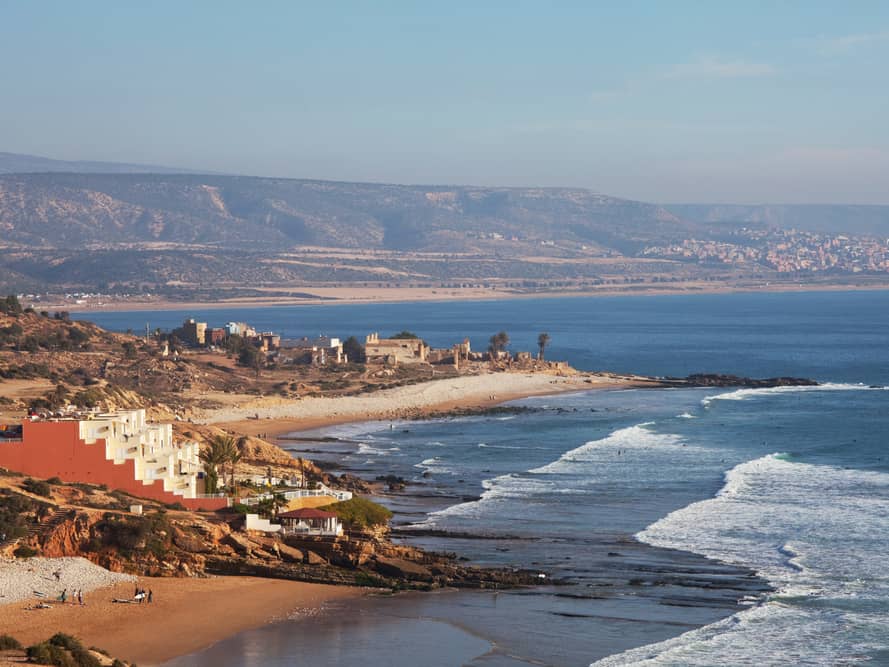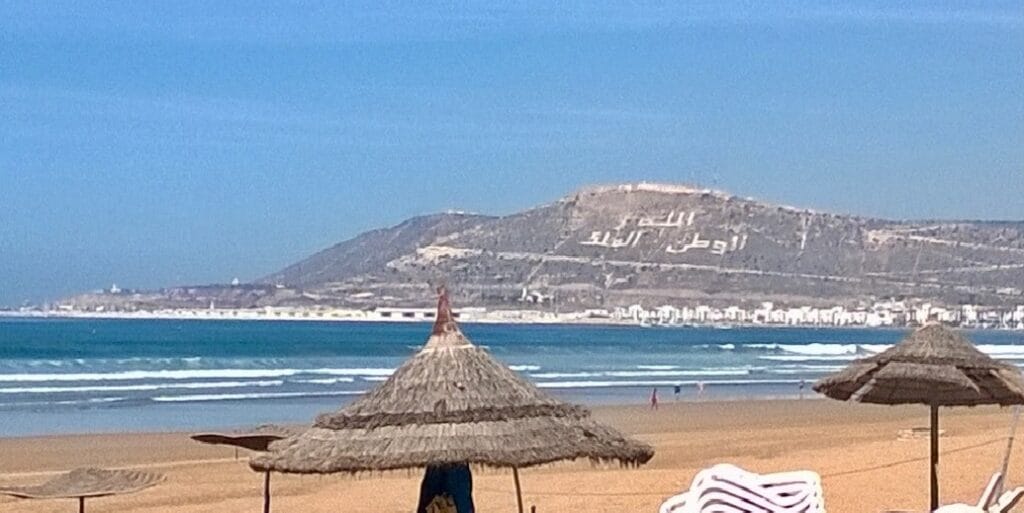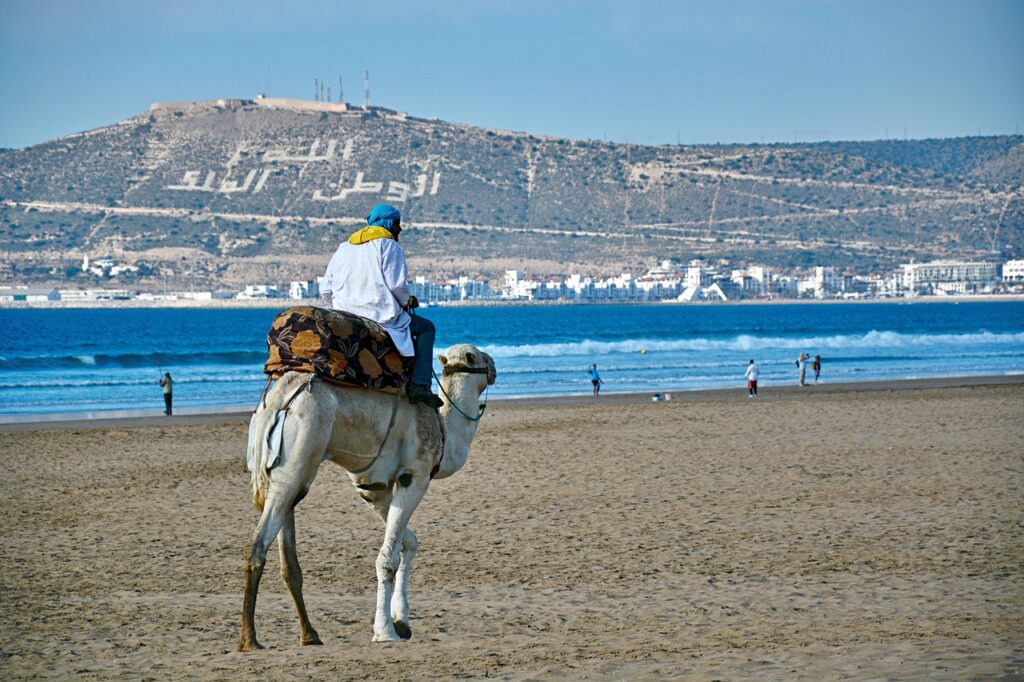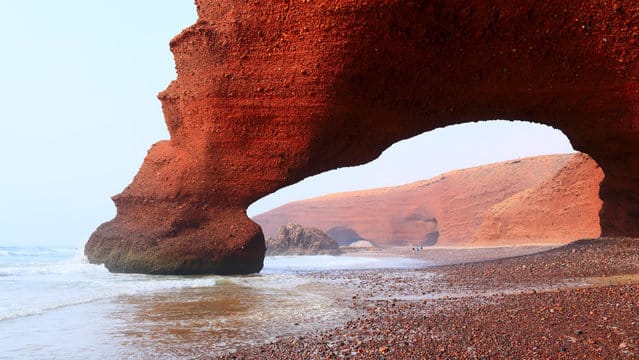Discover Agadir in Morocco: Your Ultimate Tour Guide.
Welcome to Agadir, a jewel on Morocco’s southern Atlantic coast! If you’re searching for the best countries to travel to, Morocco consistently ranks high, and Agadir in Morocco stands out as a premier destination offering a unique blend of modernity, tradition, and stunning natural beauty. Unlike the bustling imperial cities, Agadir offers a relaxed, resort-like atmosphere combined with authentic Moroccan culture. This coastal city, rebuilt with resilience and vision after a historical earthquake, beckons travelers with its expansive sandy beach, year-round sunshine, and a wide array of activities.

Planning a tour to Agadir in Morocco means preparing for an experience filled with sun-drenched days by the ocean, exploring vibrant markets, tasting exquisite local cuisine, and discovering the rich Amazigh (Berber) heritage. Whether you’re a solo traveler, a couple seeking a romantic getaway, or a family looking for adventure, Agadir provides a welcoming and accessible gateway to the wonders of southern Morocco. It serves as an excellent base for exploring nearby natural attractions like Paradise Valley and the Souss-Massa National Park. This guide will walk you through everything you need to plan an unforgettable Agadir in Morocco tour, solidifying Morocco’s reputation as one of the top countries to visit.
Historical Significance and Background:
Agadir’s history is marked by resilience. Originally a settlement of Berber fishermen, its natural bay attracted Portuguese traders in the early 16th century. The defining moment in its modern history, however, was the devastating earthquake on February 29, 1960. Registering 5.8 Mw, the quake lasted less than 15 seconds but tragically claimed the lives of 12,000-15,000 people, roughly a third of the city’s population, and destroyed ancient districts like the Kasbah, Founti, and Yachech.
The old Agadir was decimated, but under the guidance of King Mohammed V, a new city was planned and built slightly south of the original site, incorporating modern anti-seismic design standards. Today’s Agadir is a testament to that rebuilding effort – a modern, planned city with wide avenues, hotels, and a focus on tourism, yet still deeply connected to its Moroccan and Amazigh roots. The ruins of the original Kasbah (Agadir Oufella) stand on a hill overlooking the bay, offering poignant reminders of the past and spectacular views of the new city and ocean.

Why should to visit there?
Agadir offers a compelling mix of attractions:
- Stunning Beach: A 10km-long crescent of golden sand provides ample space for sunbathing, swimming, and water sports.
- Reliable Climate: Agadir boasts over 300 days of sunshine a year, making it an ideal year-round destination.
- Modern Amenities: As a major tourist hub, it offers excellent hotels, restaurants, and infrastructure.
- Cultural Blend: Experience the local Amazigh culture alongside modern Moroccan life.
- Gateway to the South: It’s a perfect starting point for excursions to the Anti-Atlas mountains, desert landscapes, and coastal villages like Taghazout.
- Relaxed Atmosphere: Compared to Marrakech or Fes, Agadir offers a more laid-back holiday vibe.
Nearest Popular Tourist Attraction:
- Taghazout: Famous surfing village just north of Agadir.
- Paradise Valley: Stunning river gorges and natural pools in the foothills of the High Atlas.
- Souss-Massa National Park: A coastal wetland reserve, vital for birdlife, particularly the northern bald ibis.
- Taroudant: Often called “Mini Marrakech,” a historic walled city east of Agadir.
- Essaouira: A charming coastal city and UNESCO World Heritage site, reachable on a day trip (though a longer drive).
- Crocoparc: A popular park housing Nile crocodiles.
- Agadir Medina (La Médina d’Agadir): A modern reconstruction of a traditional medina using traditional techniques.
How to Starting The Journey from Capital City?
Morocco’s capital is Rabat. To travel from Rabat to Agadir (approx. 500-600 km):
- By Air: The quickest option. Royal Air Maroc and Air Arabia Maroc offer flights from Rabat-Salé Airport (RBA) to Agadir Al-Massira Airport (AGA). Flight time is around 1 hour non-stop.
- By Bus: Comfortable, air-conditioned coaches run by CTM or Supratours offer a more budget-friendly option. The journey takes approximately 9-10 hours, often involving a change or stop in Marrakech.
- By Train + Bus: Take a train from Rabat to Marrakech, then connect to a Supratours or CTM bus to Agadir.
- By Car: Renting a car offers flexibility to explore along the way. The drive via the main highways takes around 6-7 hours.

Transportation Options.
Within Agadir:
- Petit Taxis: Small, usually red taxis are common for short trips within the city limits. Agree on the fare beforehand or insist on using the meter.
- Grand Taxis: Larger, often white taxis operate on fixed routes to nearby towns or can be hired for longer excursions.
- Local Buses: A network of ALSA buses serves the city and surrounding areas affordably.
- Walking: The beachfront promenade and central areas are very walkable.
- Rental Cars/Scooters: Available for more independent exploration.
Best Time To Visit there?
Agadir is a year-round destination:
- Spring (March-May) & Autumn (September-November): Considered the best times. Temperatures are warm and pleasant (around 20-25°C), ideal for sightseeing and beach time without the intense summer heat.
- Summer (June-August): Hot and sunny, with temperatures often reaching 26°C-30°C+, sometimes higher during heatwaves influenced by Sahara winds. Perfect for sun-seekers and water sports enthusiasts. It’s also peak tourist season.
- Winter (December-February): Mild daytime temperatures (around 18-20°C) but cooler evenings. Some rain is possible (Dec is the wettest month). Excellent for surfing (bigger swells), budget travel, and escaping colder climates.
Scenic Route To place?
- Coastal Drive: The N1 highway running north and south from Agadir offers stunning Atlantic coastal views, especially towards Taghazout and Essaouira.
- Mountain Roads: Day trips towards Paradise Valley or Taroudant take you through the scenic foothills of the Anti-Atlas mountains, offering dramatic landscapes.
- Approach from Marrakech: The highway journey from Marrakech crosses the High Atlas mountains, providing breathtaking mountain scenery before descending towards the Souss valley and Agadir.
Picturesque Landscapes.
Agadir and its surroundings boast diverse landscapes:
- Golden Beaches: The long, wide Agadir beach is the city’s main draw.
- Argan Forests: The endemic Argan trees dot the landscape around Agadir.
- Mountain Foothills: The nearby Anti-Atlas and High Atlas mountains provide rugged backdrops and opportunities for hiking.
- Coastal Cliffs: Dramatic cliffs can be found north and south of the city.
- River Valleys: Lush oases like Paradise Valley contrast with the arid surroundings.
Local and Traditional Culture:
Agadir is located in the Souss region, the heartland of the Amazigh (Berber) people. While modern, the city retains strong cultural roots:
- Amazigh Heritage: Visible in crafts, music, language (Tamazight), and traditions. Visit the Museum of Amazigh Culture to learn more.
- Souk El Had: Experience the vibrant atmosphere of a large traditional market, bustling with locals and offering everything from spices to carpets.
- Music: Agadir hosts the Timitar Festival, celebrating Amazigh and world music. Traditional music can sometimes be heard in restaurants or during cultural events.
- Hospitality: Moroccans are known for their warm hospitality; expect offers of mint tea.
- Craftsmanship: Look for local crafts like Argan oil products, leather goods, pottery, and Berber carpets.
Exploring The place.
Key sites to explore during your Agadir in Morocco tour:
- Agadir Beach & Promenade: Relax, swim, or stroll along the extensive beachfront walkway lined with cafes and restaurants.
- Agadir Oufella (Kasbah): Visit the hilltop ruins for historical context and the best panoramic views of the city and bay.
- Marina d’Agadir: A modern marina with shops, restaurants, and boat excursions.
- Souk El Had: Immerse yourself in one of Morocco’s largest urban markets (closed Mondays).
- Mohamed V Mosque: Admire the beautiful modern Moroccan architecture (non-Muslims can view from the outside).
- Museum of Amazigh Culture: Discover Berber history, art, and traditions.
- Vallée des Oiseaux: A small, pleasant bird park/zoo in the city center.
- La Médina d’Agadir: An artisanal and cultural space built post-earthquake using traditional methods.
Artifacts And Exhibits:
The Museum of Amazigh Culture (Musée Municipal du Patrimoine Amazigh) is the primary place to see artifacts and exhibits related to the region’s Berber heritage. It showcases traditional jewelry, carpets, pottery, woodwork, costumes, and tools, offering insight into the local culture and history. La Médina d’Agadir also features artisan workshops where you can see crafts being made.
Visitor Experience?
Visitors to Agadir typically enjoy a relaxed holiday experience focused on the beach, supplemented by cultural exploration and excursions. City tours often cover the Kasbah, Mosque, Souk, and an Argan oil cooperative. The atmosphere is generally welcoming to tourists, with many locals in the tourism sector speaking English or French. Evenings can be spent enjoying diverse dining options or strolling the promenade.
Cruise On The place?
Boat trips and cruises are available from the Agadir Marina. These can range from short coastal sightseeing trips and fishing excursions to sunset cruises. Some may offer opportunities for swimming or spotting marine life.
Wildlife And Nature:
- Souss-Massa National Park: South of Agadir, this park is crucial for birdwatching, especially the endangered Northern Bald Ibis. You might also see other waterfowl, flamingos, and potentially gazelles.
- Argan Trees: Look for the iconic sight of goats climbing Argan trees in the surrounding countryside (often seen on tours).
- Marine Life: Coastal waters host various fish species. Dolphin or whale sightings are possible but not guaranteed on boat trips.
- Crocoparc: A dedicated park housing numerous Nile crocodiles.
- Vallée des Oiseaux: Features various bird species, including some exotic ones, along with some mammals like Barbary sheep.
Local Cuisine And Traditional Dishes:
Moroccan cuisine is flavorful and diverse. In Agadir, enjoy:
- Tagine: Slow-cooked stews with meat (lamb, chicken, beef), fish, or vegetables, cooked in the iconic conical pot.
- Couscous: Traditionally served on Fridays, steamed semolina grains with stewed meat and vegetables.
- Fresh Seafood: Grilled sardines, calamari, and various types of fish are abundant due to the coastal location. Excellent near the port.
- Pastilla: A savory and sweet pie, often with pigeon or chicken (seafood versions also exist).
- Harira: A hearty lentil and tomato soup, often eaten during Ramadan.
- Msemen: Flaky, square-shaped pancakes, often served for breakfast.
- Amlou: A delicious local dip/spread made from almonds, honey, and Argan oil.
- Mint Tea: The ubiquitous drink of Moroccan hospitality.
Recommended Restaurants:
Agadir offers a range of dining from budget to fine dining:
- Pure Passion: Upscale dining at the Marina, known for seafood and romantic ambiance.
- Le Jardin d’Eau: Elegant French-Moroccan fusion cuisine in a garden setting.
- La Scala: Popular spot near the beach for seafood and Moroccan dishes.
- Bab Agadir: Offers traditional Moroccan food and atmosphere.
- Restaurants near the Fish Port: For simple, incredibly fresh grilled fish.
- Souk El Had: Great for sampling street food like grilled sardines or msemen.
- Restaurant Daffy: Known for authentic, home-style Moroccan cooking.
Accommodation Options and Budget-friendly Stays:
Agadir has accommodation for all budgets:
- Luxury Hotels & Resorts: Numerous options along the beachfront (e.g., Sofitel, Riu Palace Tikida).
- Mid-Range Hotels: Good value hotels often slightly back from the beach (e.g., Hotel Timoulay and Spa Agadir, Ocean Atlantic View).
- Apart-Hotels: Offer self-catering facilities (e.g., Appart Hotel Tagadirt – note mixed reviews).
- Budget Hotels & Guesthouses (Riads): Fewer traditional Riads than in older cities, but budget options exist (e.g., Villa du Souss – eco-friendly, near airport).
- Hostels: Catering to backpackers and surfers (e.g., The Rina Hostel, surf camps in nearby Taghazout like Nomad Surf Camp).
- Eco-Lodges: Unique stays focusing on sustainability (e.g., Atlas Kasbah – award-winning, outside the city).
Tips For A Memorable Trip:
- Pack Light Clothing: But include layers for cooler evenings, especially outside summer.
- Sun Protection: Sunglasses, hats, and high-SPF sunscreen are essential year-round.
- Stay Hydrated: Drink plenty of bottled water.
- Currency: Moroccan Dirham (MAD). ATMs are widely available; some places accept Euros but rates may vary.
- Learn Basic Phrases: “Salam Alaikum” (Hello), “Shukran” (Thank you), “La Shukran” (No Thank you), “Afak” (Please) will be appreciated.
- Haggling: Expected in souks, but do it politely and with a smile. Not customary in modern shops.
- Book Excursions: Arrange tours to Paradise Valley or Souss-Massa in advance or through reputable local operators/hotels.
Health And Safety
- Water: Drink bottled water. Avoid tap water and ice cubes in drinks.
- Food: Eat freshly cooked food. Be cautious with street food if you have a sensitive stomach. Peel fruits yourself.
- Sun: Protect yourself from strong sun exposure.
- Petty Crime: Be aware of pickpockets in crowded areas like Souk El Had or the promenade. Secure your valuables.
- Scams: Be wary of unsolicited guides or overly friendly strangers offering deals. Agree on taxi fares beforehand.
- Swimming: Pay attention to beach flags indicating water conditions.
- Insurance: Ensure you have comprehensive travel insurance covering health and theft.
- Emergency: Know the contact details for local police (dial 19) and medical assistance (dial 15).
Do’s and Don’ts:
- Do dress modestly, especially when away from the beach or visiting religious sites (shoulders and knees covered).
- Do ask permission before photographing people.
- Do accept mint tea if offered; it’s a sign of hospitality (you can politely decline if necessary).
- Do use your right hand for eating and handling items.
- Don’t drink alcohol excessively in public (it’s available in licensed hotels/restaurants).
- Don’t engage in public displays of affection.
- Don’t criticize the King, the government, or Islam.
- Don’t enter mosques if you are not Muslim (except Hassan II Mosque in Casablanca; the Mohamed V Mosque in Agadir is typically viewed from outside by non-Muslims).
Respectful Behavior:
- Be mindful that Morocco is a Muslim country. Respect local traditions and customs.
- During Ramadan, be discreet when eating, drinking, or smoking in public during fasting hours.
- Show respect to elders.
- Be patient and polite in interactions.
Conclusion:
An Agadir in Morocco tour offers a fantastic blend of relaxation, culture, and adventure. From its beautiful beach and modern amenities to its resilient history and rich Amazigh heritage, Agadir provides a unique Moroccan experience. It stands as proof that Morocco is one of the best countries to travel to, offering diverse experiences for every type of traveler. Whether you spend your days soaking up the sun, exploring bustling souks, venturing into nearby natural wonders, or simply enjoying the delicious cuisine, Agadir promises a memorable and enriching journey. Pack your bags and get ready to discover the charm of this southern Moroccan gem!

